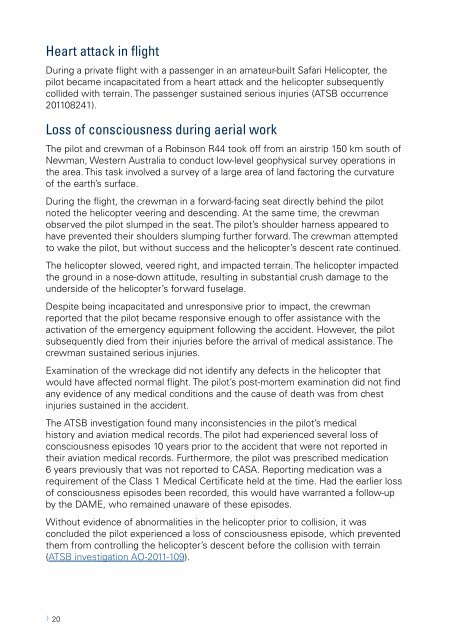Pilot incapacitation occurrences 2010–2014
8rKXy6YKY
8rKXy6YKY
Create successful ePaper yourself
Turn your PDF publications into a flip-book with our unique Google optimized e-Paper software.
Heart attack in flight<br />
During a private flight with a passenger in an amateur-built Safari Helicopter, the<br />
pilot became incapacitated from a heart attack and the helicopter subsequently<br />
collided with terrain. The passenger sustained serious injuries (ATSB occurrence<br />
201108241).<br />
Loss of consciousness during aerial work<br />
The pilot and crewman of a Robinson R44 took off from an airstrip 150 km south of<br />
Newman, Western Australia to conduct low-level geophysical survey operations in<br />
the area. This task involved a survey of a large area of land factoring the curvature<br />
of the earth’s surface.<br />
During the flight, the crewman in a forward-facing seat directly behind the pilot<br />
noted the helicopter veering and descending. At the same time, the crewman<br />
observed the pilot slumped in the seat. The pilot’s shoulder harness appeared to<br />
have prevented their shoulders slumping further forward. The crewman attempted<br />
to wake the pilot, but without success and the helicopter’s descent rate continued.<br />
The helicopter slowed, veered right, and impacted terrain. The helicopter impacted<br />
the ground in a nose-down attitude, resulting in substantial crush damage to the<br />
underside of the helicopter’s forward fuselage.<br />
Despite being incapacitated and unresponsive prior to impact, the crewman<br />
reported that the pilot became responsive enough to offer assistance with the<br />
activation of the emergency equipment following the accident. However, the pilot<br />
subsequently died from their injuries before the arrival of medical assistance. The<br />
crewman sustained serious injuries.<br />
Examination of the wreckage did not identify any defects in the helicopter that<br />
would have affected normal flight. The pilot’s post-mortem examination did not find<br />
any evidence of any medical conditions and the cause of death was from chest<br />
injuries sustained in the accident.<br />
The ATSB investigation found many inconsistencies in the pilot’s medical<br />
history and aviation medical records. The pilot had experienced several loss of<br />
consciousness episodes 10 years prior to the accident that were not reported in<br />
their aviation medical records. Furthermore, the pilot was prescribed medication<br />
6 years previously that was not reported to CASA. Reporting medication was a<br />
requirement of the Class 1 Medical Certificate held at the time. Had the earlier loss<br />
of consciousness episodes been recorded, this would have warranted a follow-up<br />
by the DAME, who remained unaware of these episodes.<br />
Without evidence of abnormalities in the helicopter prior to collision, it was<br />
concluded the pilot experienced a loss of consciousness episode, which prevented<br />
them from controlling the helicopter’s descent before the collision with terrain<br />
(ATSB investigation AO-2011-109).<br />
› 20


